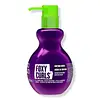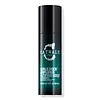What's inside
What's inside
 Key Ingredients
Key Ingredients

No key ingredients
 Benefits
Benefits

 Concerns
Concerns

 Ingredients Side-by-side
Ingredients Side-by-side

Water
Skin ConditioningVp/Dimethylaminoethylmethacrylate Copolymer
Cyclopentasiloxane
EmollientParfum
MaskingAcrylates Copolymer
Phenoxyethanol
PreservativePhenyl Trimethicone
Skin ConditioningPropylene Glycol Dibenzoate
Skin ConditioningCaprylyl Glycol
EmollientDimethiconol
EmollientSodium Polyacrylate
AbsorbentArgania Spinosa Kernel Oil
EmollientBenzyl Alcohol
PerfumingHydrogenated Polydecene
EmollientAminomethyl Propanol
BufferingCarbomer
Emulsion StabilisingDisodium EDTA
Pentylene Glycol
Skin ConditioningTrideceth-6
EmulsifyingAmmonium Hydroxide
BufferingLinalool
PerfumingWater, Vp/Dimethylaminoethylmethacrylate Copolymer, Cyclopentasiloxane, Parfum, Acrylates Copolymer, Phenoxyethanol, Phenyl Trimethicone, Propylene Glycol Dibenzoate, Caprylyl Glycol, Dimethiconol, Sodium Polyacrylate, Argania Spinosa Kernel Oil, Benzyl Alcohol, Hydrogenated Polydecene, Aminomethyl Propanol, Carbomer, Disodium EDTA, Pentylene Glycol, Trideceth-6, Ammonium Hydroxide, Linalool
Water
Skin ConditioningPolyquaternium-37
Vp/Dmapa Acrylates Copolymer
Cyclopentasiloxane
EmollientPolyquaternium-11
Parfum
MaskingPhenoxyethanol
PreservativePropylene Glycol Dicaprylate/Dicaprate
EmollientCetearyl Alcohol
EmollientPolysorbate 60
EmulsifyingC12-15 Alkyl Benzoate
AntimicrobialPPG-1 Trideceth-6
Skin ConditioningHelianthus Annuus Seed Oil
EmollientDisodium EDTA
PEG-4 Dilaurate
EmulsifyingPEG-4 Laurate
EmulsifyingSorbitan Oleate
EmulsifyingAlcohol Denat.
AntimicrobialVp/Dimethylaminoethylmethacrylate Copolymer
Benzalkonium Chloride
AntimicrobialCaprylyl Glycol
EmollientPanthenol
Skin ConditioningIodopropynyl Butylcarbamate
PreservativePEG-4
HumectantSimmondsia Chinensis Seed Oil
EmollientButylene Glycol
HumectantHelianthus Annuus Seed Extract
Skin ConditioningChitosan
Bacopa Monnieri Extract
Skin ConditioningGlycerin
HumectantCitric Acid
BufferingTocopherol
AntioxidantAmyl Cinnamal
PerfumingBenzyl Salicylate
PerfumingCitral
PerfumingCitronellol
PerfumingGeraniol
PerfumingHexyl Cinnamal
PerfumingHydroxycitronellal
PerfumingLimonene
PerfumingLinalool
PerfumingWater, Polyquaternium-37, Vp/Dmapa Acrylates Copolymer, Cyclopentasiloxane, Polyquaternium-11, Parfum, Phenoxyethanol, Propylene Glycol Dicaprylate/Dicaprate, Cetearyl Alcohol, Polysorbate 60, C12-15 Alkyl Benzoate, PPG-1 Trideceth-6, Helianthus Annuus Seed Oil, Disodium EDTA, PEG-4 Dilaurate, PEG-4 Laurate, Sorbitan Oleate, Alcohol Denat., Vp/Dimethylaminoethylmethacrylate Copolymer, Benzalkonium Chloride, Caprylyl Glycol, Panthenol, Iodopropynyl Butylcarbamate, PEG-4, Simmondsia Chinensis Seed Oil, Butylene Glycol, Helianthus Annuus Seed Extract, Chitosan, Bacopa Monnieri Extract, Glycerin, Citric Acid, Tocopherol, Amyl Cinnamal, Benzyl Salicylate, Citral, Citronellol, Geraniol, Hexyl Cinnamal, Hydroxycitronellal, Limonene, Linalool
Ingredients Explained
These ingredients are found in both products.
Ingredients higher up in an ingredient list are typically present in a larger amount.
Caprylyl Glycol is a humectant and emollient, meaning it attracts and preserves moisture.
It is a common ingredient in many products, especially those designed to hydrate skin. The primary benefits are retaining moisture, skin softening, and promoting a healthy skin barrier.
Though Caprylyl Glycol is an alcohol derived from fatty acids, it is not the kind that can dry out skin.
This ingredient is also used as a preservative to extend the life of products. It has slight antimicrobial properties.
Learn more about Caprylyl GlycolCyclopentasiloxane, or D5, is a silicone used to improve texture of products and trap moisture.
D5 is considered lightweight and volatile. Volatile means it evaporates quickly after application. Once evaporated, D5 leaves a thin barrier that helps keep skin hydrated.
It is also an emollient. Emollients help soften the skin and prevent water loss. Silicones create a silky texture in products. D5 helps other ingredients become more spreadable.
Studies show D5 is safe to use in skincare products. We recommend speaking with a skincare professional if you have concerns.
Learn more about CyclopentasiloxaneDisodium EDTA plays a role in making products more stable by aiding other preservatives.
It is a chelating agent, meaning it neutralizes metal ions that may be found in a product.
Disodium EDTA is a salt of edetic acid and is found to be safe in cosmetic ingredients.
Learn more about Disodium EDTALinalool is a fragrance and helps add scent to products. It's derived from common plants such as cinnamon, mint, citrus, and lavender.
Like Limonene, this ingredient oxidizes when exposed to air. Oxidized linalool can cause allergies and skin sensitivity.
This ingredient has a scent that is floral, spicy tropical, and citrus-like.
Learn more about LinaloolParfum is a catch-all term for an ingredient or more that is used to give a scent to products.
Also called "fragrance", this ingredient can be a blend of hundreds of chemicals or plant oils. This means every product with "fragrance" or "parfum" in the ingredients list is a different mixture.
For instance, Habanolide is a proprietary trade name for a specific aroma chemical. When used as a fragrance ingredient in cosmetics, most aroma chemicals fall under the broad labeling category of “FRAGRANCE” or “PARFUM” according to EU and US regulations.
The term 'parfum' or 'fragrance' is not regulated in many countries. In many cases, it is up to the brand to define this term.
For instance, many brands choose to label themselves as "fragrance-free" because they are not using synthetic fragrances. However, their products may still contain ingredients such as essential oils that are considered a fragrance by INCI standards.
One example is Calendula flower extract. Calendula is an essential oil that still imparts a scent or 'fragrance'.
Depending on the blend, the ingredients in the mixture can cause allergies and sensitivities on the skin. Some ingredients that are known EU allergens include linalool and citronellol.
Parfum can also be used to mask or cover an unpleasant scent.
The bottom line is: not all fragrances/parfum/ingredients are created equally. If you are worried about fragrances, we recommend taking a closer look at an ingredient. And of course, we always recommend speaking with a professional.
Learn more about ParfumPhenoxyethanol is a preservative that has germicide, antimicrobial, and aromatic properties. Studies show that phenoxyethanol can prevent microbial growth. By itself, it has a scent that is similar to that of a rose.
It's often used in formulations along with Caprylyl Glycol to preserve the shelf life of products.
We don't have a description for Vp/Dimethylaminoethylmethacrylate Copolymer yet.
Water. It's the most common cosmetic ingredient of all. You'll usually see it at the top of ingredient lists, meaning that it makes up the largest part of the product.
So why is it so popular? Water most often acts as a solvent - this means that it helps dissolve other ingredients into the formulation.
You'll also recognize water as that liquid we all need to stay alive. If you see this, drink a glass of water. Stay hydrated!
Learn more about Water